American Gold Type Set
$1 Gold Coins 1849-1889
The smallest coin in U.S. history owes its existence to two of the biggest gold rushes. That coin is the gold dollar, a mere pipsqueak physically, but giant in terms of history, rarity, and value.
The groundwork was laid for this fascinating coin in the Carolinas and Georgia, where the nation’s first gold rush took place in the early 1800’s. That rush had a major impact on Unites States coinage, leading the establishment of two branch mints in the region, Charlotte, North Carolina and Dahlonega, Georgia.
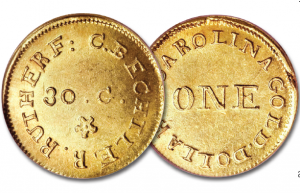 The first gold dollars made in the United States were privately minted in 1830 by a German immigrant, Alt Christoph Bechtler, who operated a jewelry shop in Rutherfordton, North Carolina. Bechtler knew that gold dust and nuggets were the primary medium of exchange in the area and began advertising, offering to refine raw gold into coins for a nominal fee.
The first gold dollars made in the United States were privately minted in 1830 by a German immigrant, Alt Christoph Bechtler, who operated a jewelry shop in Rutherfordton, North Carolina. Bechtler knew that gold dust and nuggets were the primary medium of exchange in the area and began advertising, offering to refine raw gold into coins for a nominal fee.
By 1840, Bechtler and his family had turned out more than $2.2 million worth of gold coins, which over half were gold dollars. This was legal under the existing federal statutes, but Uncle Sam began to watch the Bechtlers closely. The success of their venture led to calls for the government to issue gold dollar coins. In 1836, Congress authorized such coins, but the Mint Director, Robert M. Patterson, opposed the idea vehemently and limited his compliance to striking only a handful of patterns.
The gold dollar didn’t take its place in U.S. coinage until 1849, with another gold rush providing the spark. In 1848, the gold rush in California energized. Congress to expand uses of the metal in U.S. coinage and find some new ones. The Mint Director, Robert M. Patterson, still opposed such coinage, but his resistance was swept aside. On March 3, 1849, Congress passed legislation authorizing the gold dollars.
Type I
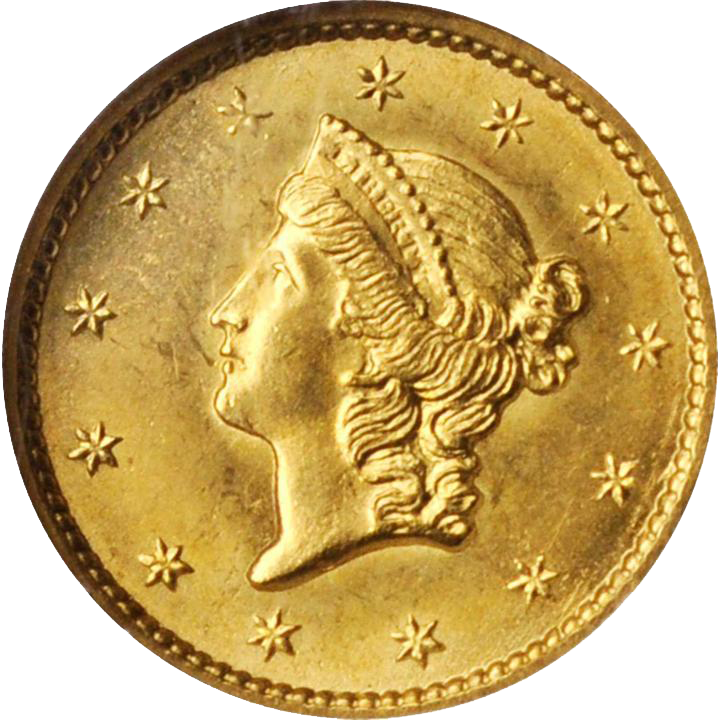
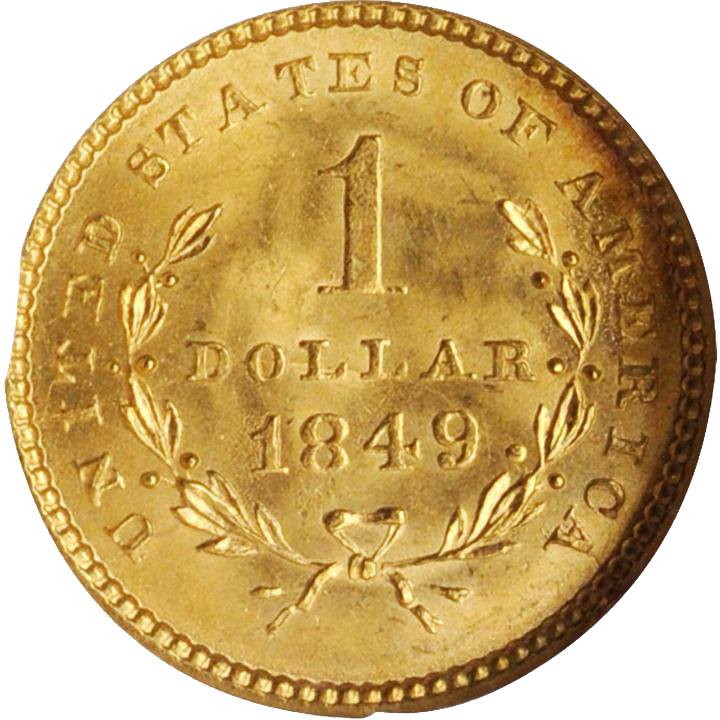
The designing of the gold dollar fell on James Barton Longacre, the U.S. Mint’s chief engraver. The obverse design he came up with has a left-facing portrait of Miss Liberty with a coronet, or small crown, in her hair. On the dollar, she is encircled by 13 stars, symbolic of the original 13 colonies. The dollar’s reverse is necessarily simple because of the coin’s small size. It bears the denomination “1 DOLLAR” and the date within a simple wreath, which is encircled by the inscription, “UNITED STATES OF AMERICA.” The design would remain in use until 1854 before giving way to an “Indian Head” portrait along with other modifications. There are three distinct types of gold dollars, with the “Liberty Head” version of 1849-1854 being known as the “Type I.”
During the first six years of production, Type I gold dollars were struck at five different mints: Philadelphia (no mint mark), Charlotte (C), Dahlonega (D), New Orleans (O), and San Francisco (S), but only the Philadelphia and Dahlonega mints issued them every year. Mintages, for the most part, were relatively high at the Philadelphia while the other four mints mintages were very low. Collecting the dates and mint marks are usually done in circulated grades. The rarity of high graded pieces generally limits collectors to just one example for their type sets.
Throughout U.S. history, people have grumbled that the silver dollar was too large and heavy to carry around. Gold dollars were the answer, but posed a dramatically different problem. The gold dollar is less than three-quarters the size of today’s dime. They could easily be mislaid and lost!
Type II
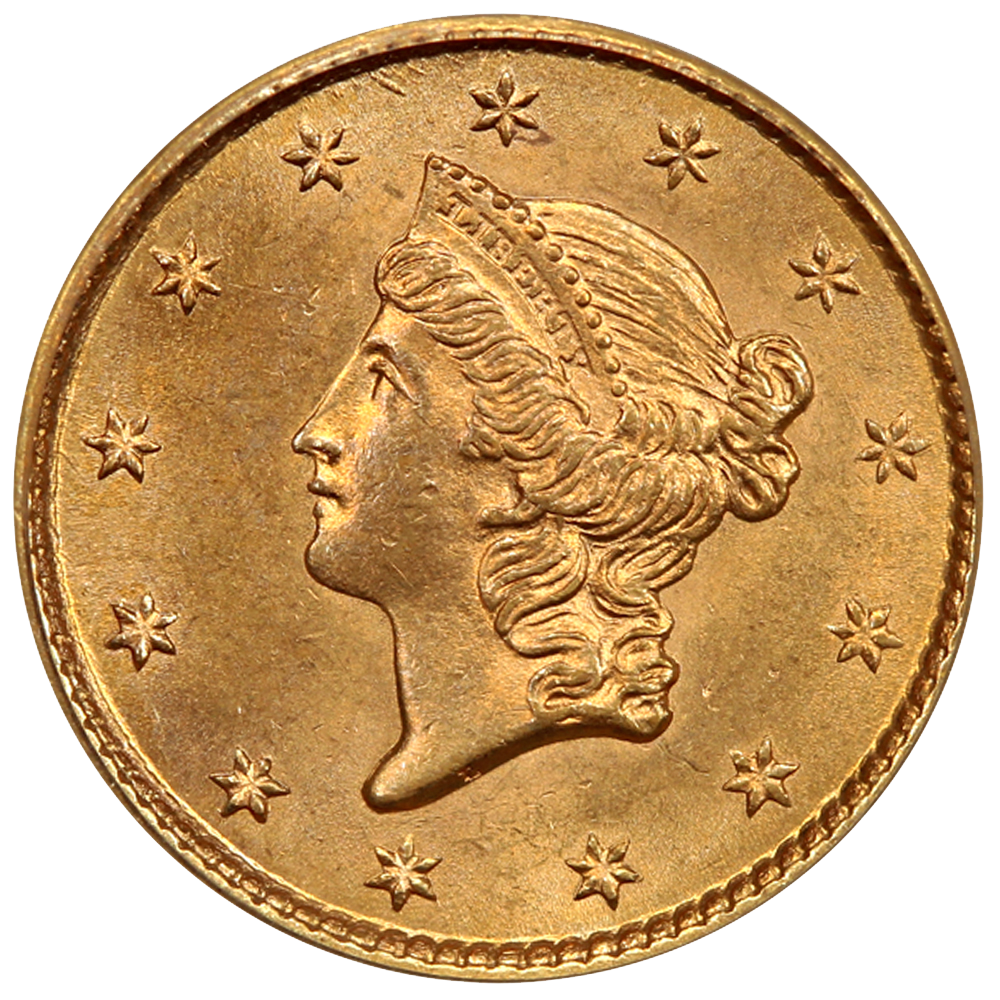
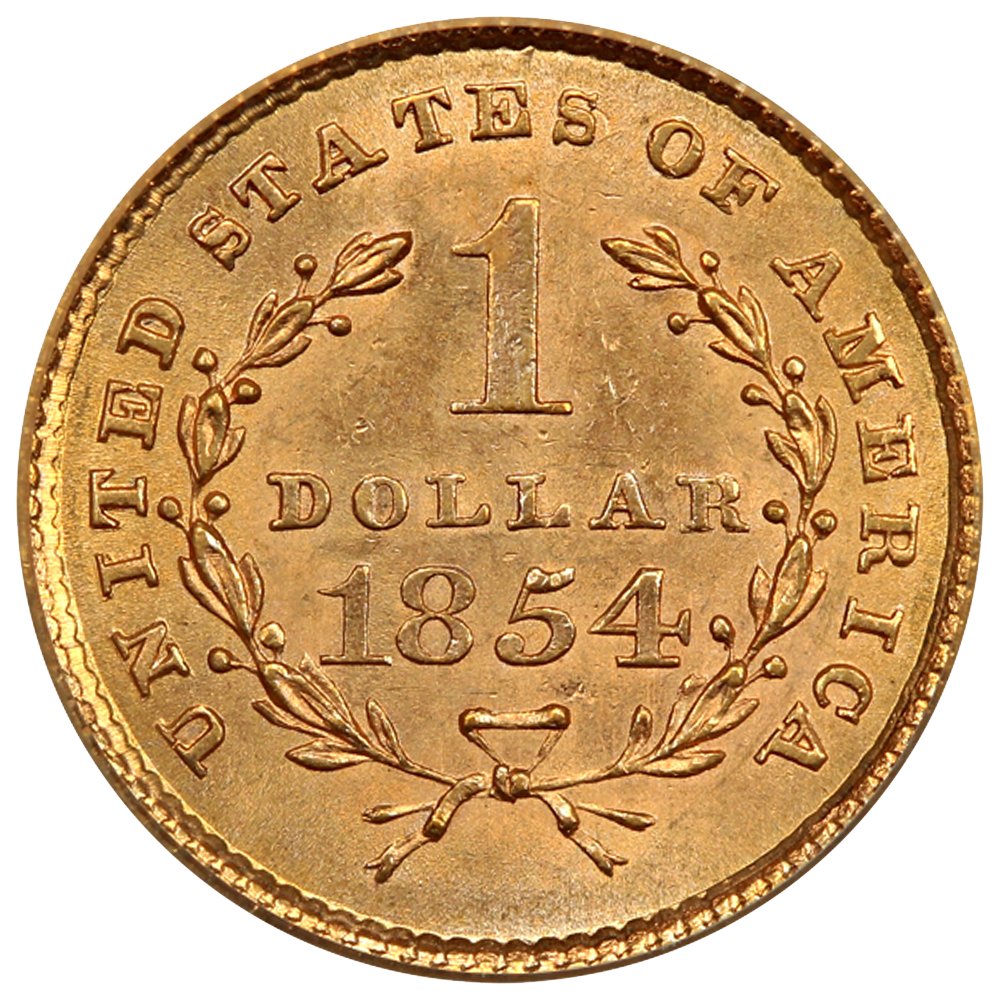
The gold dollar is the smallest United States issued gold coin in history. During the minting of the Type I Gold Dollars, objections arose, almost at once, to the dollar’s size of only 13 millimeters in diameter, claiming that the coin’s size made it easy to lose. Mint officials took these protests seriously. Over the next few years, test strikes were made of a number of possible substitutes that were larger in diameter, but compensated for this with holes in the center of the coin.
In 1853, the process took a different turn when James Ross Snowden became the new Mint Director. Snowden agreed the gold dollar should be bigger, but instead of using a hole to keep the weight the same, he advocated making the coin somewhat thinner. He assigned Chief Engraver, James Longacre, to make this modification, and at the same time, come up with a new design. Longacre’s initial design of the gold dollar had a head of Liberty. However, when Snowden ordered the changes, Longacre had a new model available. He had just designed the three-dollar gold piece and patterned the new gold dollar after that. The new gold dollar’s obverse features a left-facing portrait of a female figure wearing a fancy headdress. The female figure is frequently described as being an “Indian princess.” Longacre’s reverse design shows the date and denomination with a wreath of corn, cotton, wheat, and tobacco, the nation’s four major cash crops of that time.
The new Type II design of the gold dollar was 15% larger in diameter, making it easier to keep track of and less likely to get lost like its predecessor had been. Unfortunately, it had a major short coming of its own. Longacre made the relief on the obverse too high, resulting in the over whelming majority of the coins not being fully struck. Very few examples exhibit sharp details, with branch mint issues being particularly weak. Because of striking difficulties, Longacre had to go back to the drawing board again, making the Type II gold dollar only lasting for three years, thus making way for the Type III in 1856. A complete date and mint mark set of Type II Gold Dollars would only consist of just six coins. It’s estimated that less than 1% of the Type II dollar mintages still exist in all grades. The coins wore down so quickly when exposed to circulation. Within a few years, the majority of the coins were rendered almost illegible.
Type III
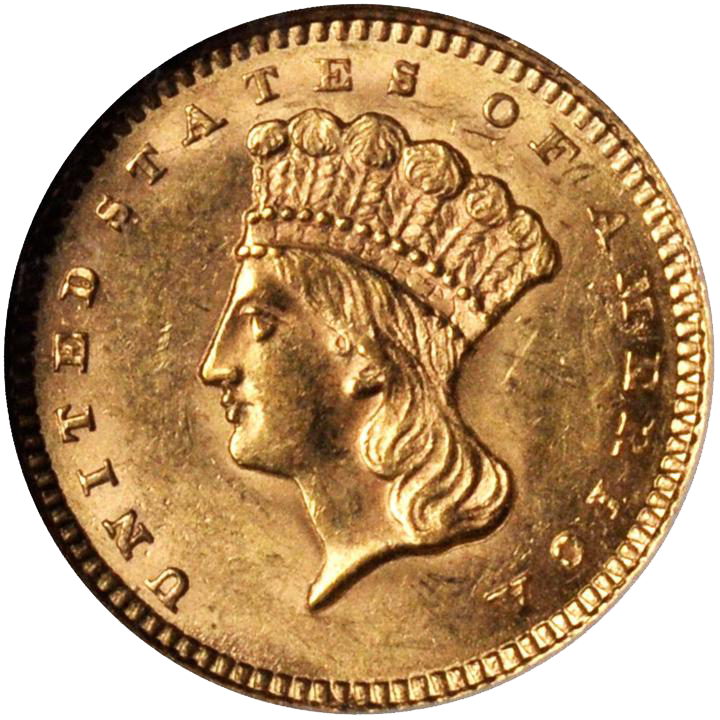
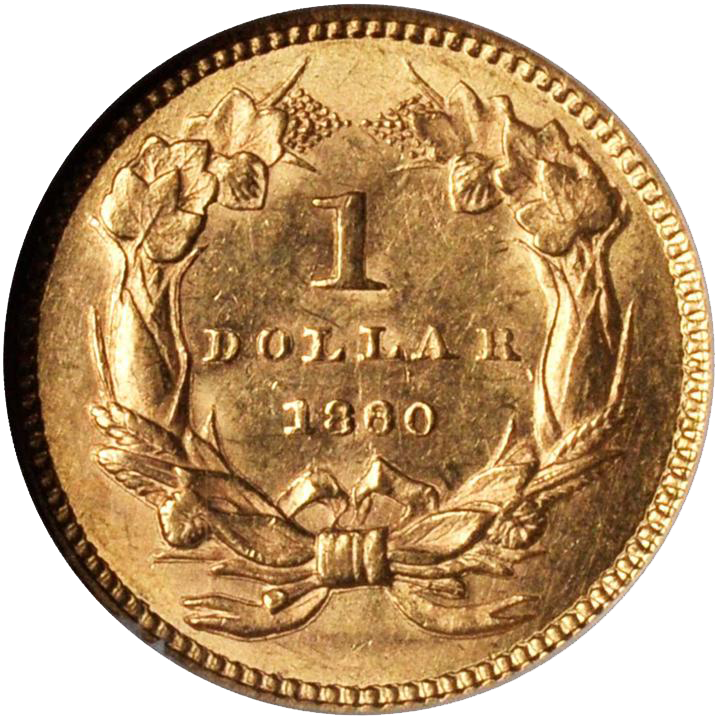
If at first you don’t succeed, try again. If you don’t succeed the second time, try once more! That was the philosophy that guided the United States Mint in producing this nation’s smallest coin, the gold dollar.
It was in 1856, when Longacre had to try again. He applied the same principle to the obverse design as he did two years earlier on the Type II Gold Dollar, but this time, enlarging the portrait and making it flatter. Although the size and configuration of the portrait differ on the Type II and Type III gold dollars, both have essentially the same design. On both, the obverse features a female figure commonly described as an “Indian Princess,” and both are therefore known as “Indian Head” types.
Besides enlarging the portrait’s size and reducing its three-dimensional depth, Longacre also moved the inscription UNITED STATES OF AMERICA closer to the border on the obverse, where it encircles the Indian Head.” On the Type II coins, it had been directly opposite the wreath on the reverse, which made it harder to strike both sides with sharp details. Unlike the Type I gold dollar, the number “1” is entirely inside the wreath on the Type II and Type III gold dollars.
Mintages were highest in the early years, partly because worn out, or uncurrent gold coins, were being recoined at the time. In 1861 and 1862, large numbers of Type I gold dollars were hitting the melting pot for recoinage. In the early years, the Charlotte and Dahlonega branch mints were minting gold dollars on a regular basis, but in miniscule numbers. Unfortunately, those two branch mints were closed in 1861, following the outbreak of the Civil War. After that, the coins were struck almost exclusively in Philadelphia, the only exception being the 1870-S Gold Dollar that was struck at San Francisco. After 1862, mintages seldomly topped 10,000 pieces. The low point came in 1875, when just 400 business strikes were made in Philadelphia. Of the Type III gold dollars, the 1861-D, struck at Dahlonega, is considered the key date of all three types. The Confederates struck and unknown amount of dollars when they took over the Dahlonega mint in 1861. It’s reported that only a handful survive today. All Type III gold dollars had low mintages and are quite rare, except for years between 1882 through 1889, which are more attainable in higher grades.
It took three tries to perfect the nation’s smallest gold coin, and the third was the charm. From then on, the gold dollar’s size and durability both proved satisfactory, and production continued without interruption for more than three decades until the denomination was discontinued in 1889. Its 33-year life span coincided with one of the most turbulent periods in American history, a third of the century comprising of the Civil War, the Reconstruction Era and the Indian wars in the West, all leaving marks on the gold dollar series.
Coronet Liberties 1840-1907
The series of Coronet Liberties contain many individual rarities, some of legendary status, and a large number of scarce issues.
Beginning in 1834, the Mint began to search for a suitable design that could serve as an enduring symbol on American gold coins. In that year, engraver William Kneass, executed a head of Liberty for $2.5 quarter eagles and $5 half eagles that became known as the Classic Head design. This design, although modified several times, was not to last as it was adapted from John Reich’s old Classic Head motif first used on large cents in 1808. By 1838, Christian Gobrecht’s Coronet Liberty design took center stage. The first to be coined using Gobrecht’s Coronet Liberty design was the $10 eagle beginning in 1838. The $2.5 quarter eagle and $5 half eagle followed suit shortly after in 1839 and 1840. The design as finally adopted, featured a large head of Liberty facing left, wearing a wide coronet inscribed with the word LIBERTY. Her hair is pulled back in a bun and held in place by a string of pearls. Thirteen stars are placed round the periphery, representing the original thirteen colonies, with the date below. The eagle on the reverse was essentially the same one that had been on the quarter eagles since 1808. Originally designed by John Reich, the 1838-1907 version was modified by Gobrecht. For the fractional gold coins, $2.5, $5, and $10 eagles, the Heraldic eagle has its wings spread from rim to rim with the Union Shield covering its breasts. In the eagle’s right claw, is an olive branch representing the country’s peaceful intentions, with three arrows emphasizing military preparedness in the left. The legend UNITED STATES OF AMERICA surround the eagle, with the denomination beneath the eagle. Between 1838-1908, the Coronet Liberty eagles were struck at six different mints depending on the coin’s size. The smaller fractional pieces, $2.5 quarter eagle and $5 half eagle, were struck at all five U.S. mints: Philadelphia (no mint mark), Charlotte (C), Dahlonega (D), New Orleans (O), and San Francisco (S). The mintmarks can be found beneath the eagle on the reverse of the coin. The larger denominations, the $10 eagle and $20 double eagle, were only struck at Philadelphia, New Orleans, and San Francisco for the most part. In 1870, the Carson City branch mint struck some of its own, producing only $5, $10 and $20 gold coins, but in very limited quantities. Toward the end of the series, its last two remaining years, 1906 and 1907, the Denver mint struck its own Coronet Liberties, but limited to only the $5, $10, and $20 gold coins, allowing the “D” mintmark to appear on U.S. gold coinage once again.
The series of Coronet Liberties contain many individual rarities, some of legendary status, and a large number of scarce issues. Its exceptional length for the $2.5 and $5 Coronet Liberties, remained unchanged for 69 years, unlike the larger denomination of the $10 and $20 gold coins that received the motto, “In God We Trust,” in 1866. This makes it a very difficult series to complete. In the first half of the century, America was at odds with itself. Here was the land of the free, a great democracy rooted in puritanical morality, yet with broad support for institutionalized slavery. This contradiction would ultimately tear the country apart, culminating the Civil War. After the Civil War, during the era of Reconstruction, recognizing public sentiment over the suffering all had shared, Congress passed the Act of March 3, 1865, authorizing the motto to appear “on all coins able to accommodate it.” Although most collectors seek a single high-grade example for type sets, others expand their horizons to include one coin from each mint, but even that is challenging. Charlotte and Dahlonega mint issues are particularly rare and expensive in mint condition, and these pieces are the keys to any collection of the six mints. San Francisco, and mainly the New Orleans issues, are also very scarce in AU (Almost Uncirculated) and mint state, but are generally under-valued compared to other mintmarked gold coins with similar mintages and survival rates. Philadelphia does have its rarities though, mainly its Civil War issues and dates from 1868-1877, when species payments were still suspended. Those issues are quite elusive today. The unchanging durability of the Coronet design is unrivalled in the history of U.S. coinage. This exceptionally long span of time still stands as the longest uninterrupted use of a coin design without a major design alteration. When the first coins were struck in 1838, much of the United States was still a rough and tumble frontier that valued hard cider and log cabins enough to elect as their leader, the course old Indian fighter, William Henry Harrison. As the final Coronet Liberties were struck in 1907, America was in many ways a different country than it had been in 1838. It retained the rugged individualism that characterized the national spirit throughout the 19th century, but was a more mature America, heralded not only for its powerful economic and military presence throughout the world, but for its diplomatic achievements as well.
$2.50 Coronet Liberty Quarter Eagle
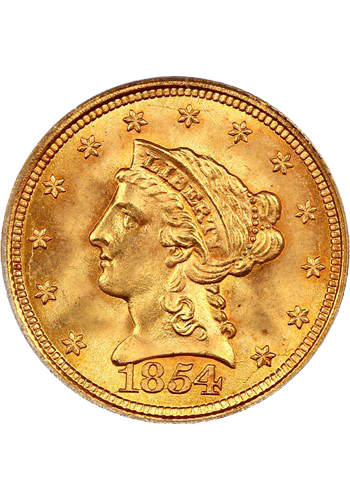
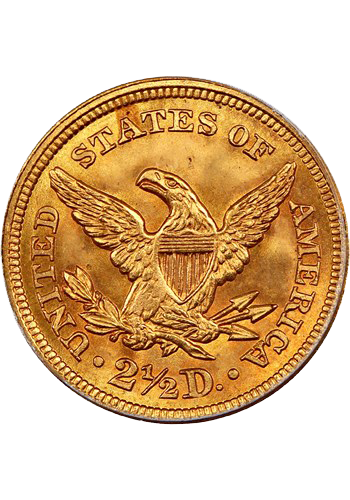
$5 Coronet Liberty Half Eagle
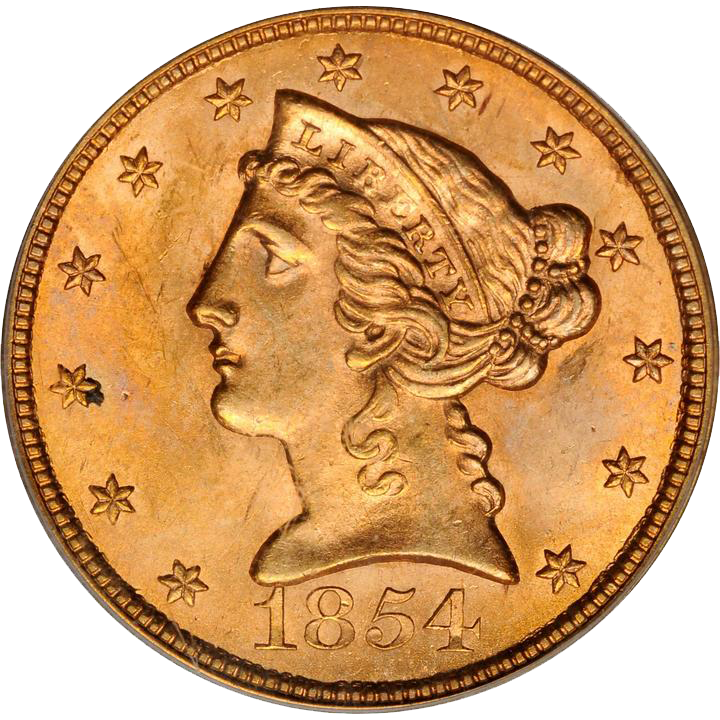
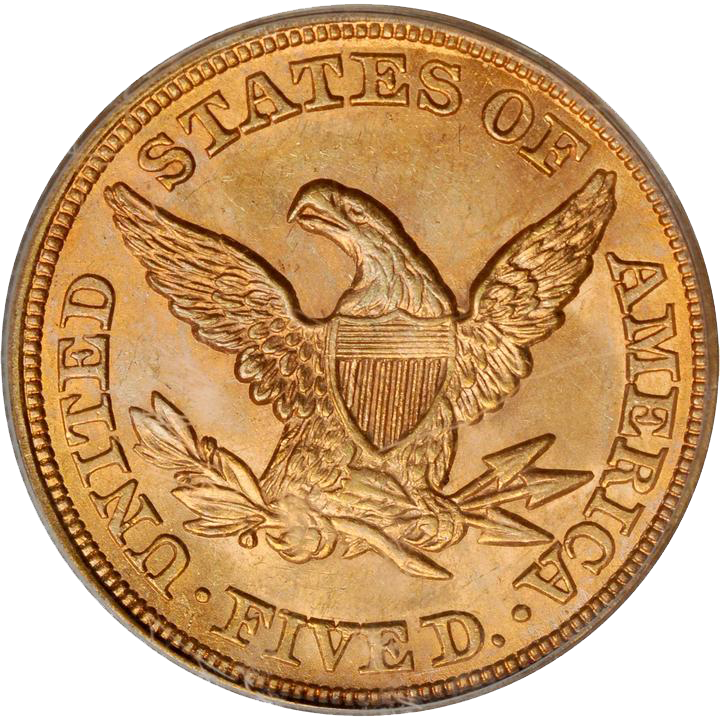
$10 Coronet Liberty Eagle
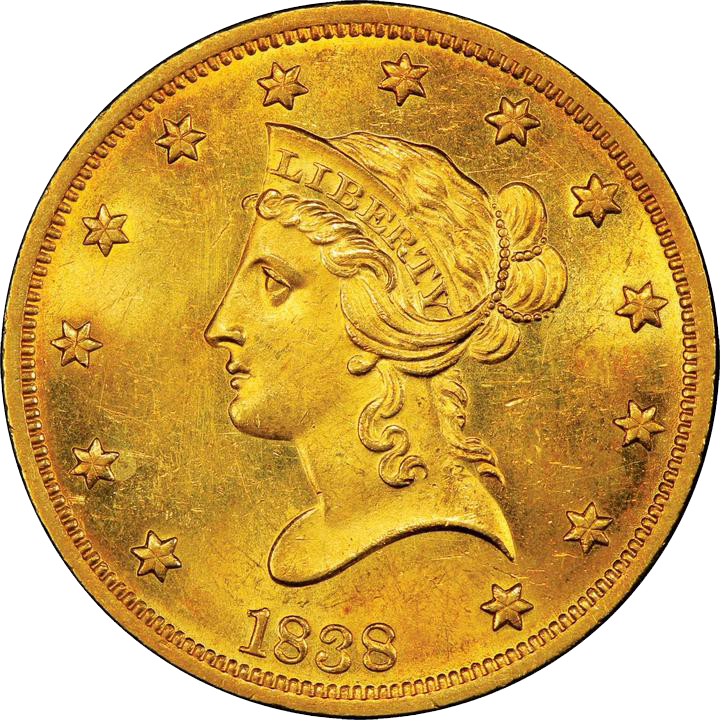
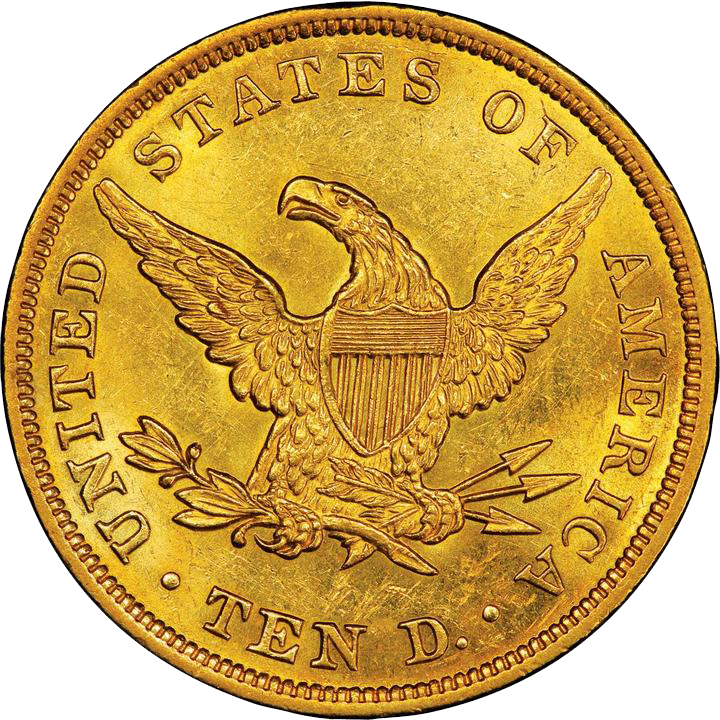
$20 Coronet Liberty Double Eagle
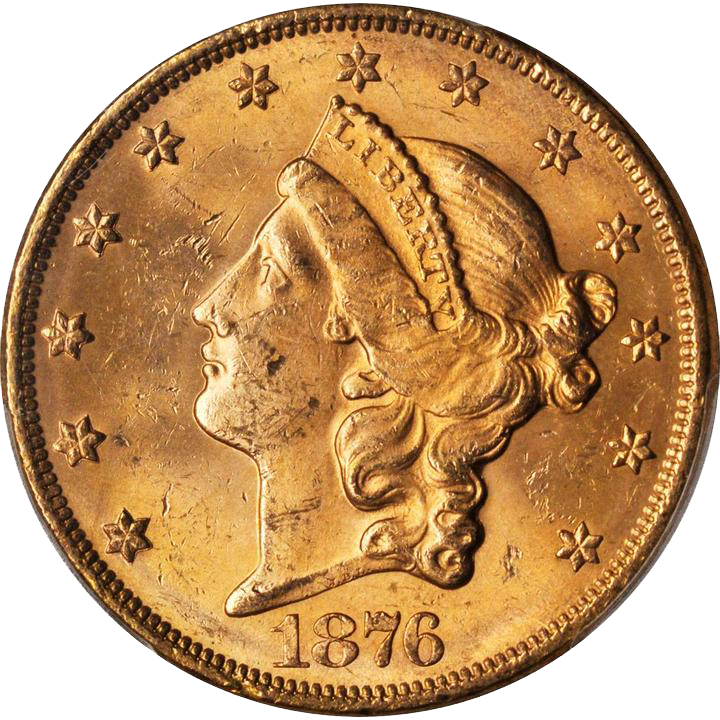
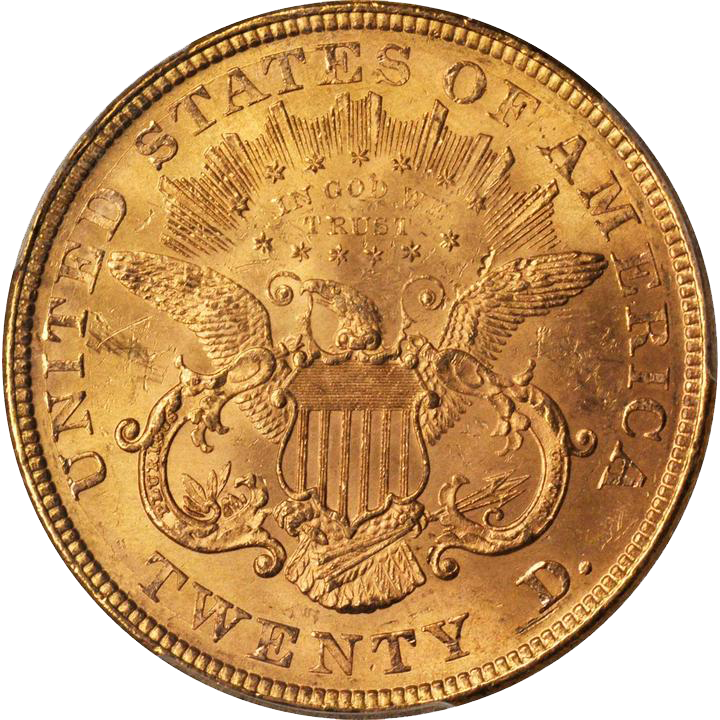
$3 Gold Piece 1854-1889
On the $3-dollar coin, Liberty is wearing a feathered headdress of equal-sized plumes with a band bearing LIBERTY
in raised letters. She’s surrounded by the inscription UNITED STATES OF AMERICA. Such a headdress dates back to the earliest
known drawings of American Indians.
In 1853, the United States negotiated the “Gadsden Purchase,” the settlement boundary dispute with Mexico that resulted in the acquisition of the southern parts of Arizona and New Mexico for 10 million dollars. Shortly after, Commodore Mathew Perry made his expedition to re-open Japan to the Western world and establish trade. Spreading beyond its borders in many ways, a few years earlier the United States had joined the worldwide move to uniform postage rates and printed stamps when the Congressional Act of March 3, 1845 authorized the first U.S. postage stamps, setting the rate at five cents. This set the stage for the close connection between postal and coinage history.
Six years later, the postage rate was reduced to three cents when the New York senator, Daniels Dickinson, wrote the legislation that simultaneously initiated coinage of the tiny three-cent piece as a public convenience. This reasoning was carried a step further when the Mint Act of February 21, 1853 authorized a three-dollar gold coin. The Mint Director, Robert Maskell Patterson, and Congress were convinced that the new coin would make it easier and speed up purchases of the three-cent stamps by the sheet. Unfortunately, at no time during the 35-year span of this denomination did the public’s demand justify the hopes of the $3-dollar gold coin. The Chief Engraver, James B. Longacre, chose the “Indian Princess” for his obverse, the same “Indian Princess” used on his Type II gold dollar in 1854 and again on the Type III gold dollar. This distinctive, sharp profile was used again on the Indian head cent of 1859.
The coin’s design was much like the gold dollar coins issued in 1854-1889, as Longacre was already designing the $3-dollar gold coin. On the $3-dollar coin, Liberty is wearing a feathered headdress of equal-sized plumes with a band bearing LIBERTY in raised letters. She’s surrounded by the inscription UNITED STATES OF AMERICA. Such a headdress dates back to the earliest known drawings of American Indians. It was accepted by engravers and medalists of the day as the design was shorthand for “America.” Longacre’s reverse of the $3 gold piece depicted a wreath of the major cash crops of that time, tobacco, wheat, corn, and cotton. Atop the wreath was a plant bearing two conical seed masses. Encircled by the wreath is the denomination, 3 DOLLARS, and the date. There are two boldly different types of reverses, the small DOLLARS, appearing on the 1854, and the large DOLLARS on coins of 1855-1889.
Over the 35-year span of striking $3 gold coins, there were just over 535,000 pieces issued. The business strikes or circulation strikes began production on May 1, 1854 with 138,618 pieces struck at Philadelphia, 1,120 pieces at the Dahlonega mint, and 24,000 pieces struck at New Orleans. The New Orleans and Dahlonega branch mints would only strike coins for one year, 1854. The 1854-O and 1854-D $3 gold coins are by far the most sought after in the series.
Every U.S. denomination boasts a number of major rarities, the $3-dollar gold coinage of 1854-1889 is studded with so many low mintage dates that it’s fair to say the entire series can be called rare. In mint state, the 1878 and 1874 are the most common, followed by the 1879 and 1854. Every other date is very rare in high grade, particularly the 1858 and 1865, as miniscule mintages were the rule in the later years of the series. It’s very important to buy coins that are certified, mainly the $3-dollar coins, as counterfeits are known for many dates.
The $3-dollar gold coinage quietly expired in 1889 along with the gold dollar. America’s coinage was certainly more prosaic without this odd denomination gold piece, but its future popularity with collectors and investors would vastly outstrip the lukewarm public reception it enjoyed during its circulating life. Very few mint state examples survived with most being found in heavily circulated conditions of Fine and Very Fine grades. Many of them are damaged from the use of jewelry as they were fashioned into “love tokens.” The popularity of such mementos peaked during the 1880’s, and numerous gold dollars, quarter eagles and $3 gold pieces succumbed to this folk art. Remember, buying certified coins is very smart as it ensures you the coin is authentic, but if looking at raw, uncertified coins, always look carefully as many may have been repaired to disguise old mountings or other signs of jewelry use.
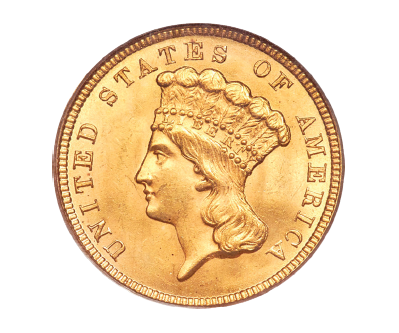
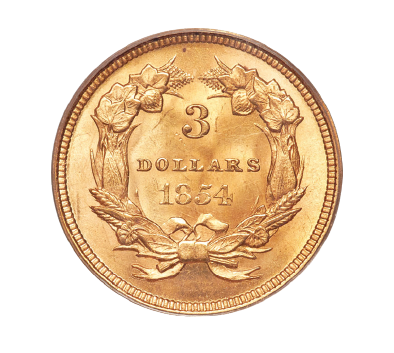
Roosevelt's Collection
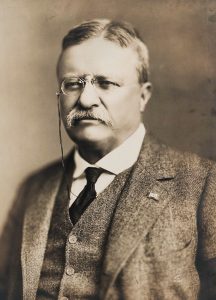
$2.5 Indian Head Quarter Eagle
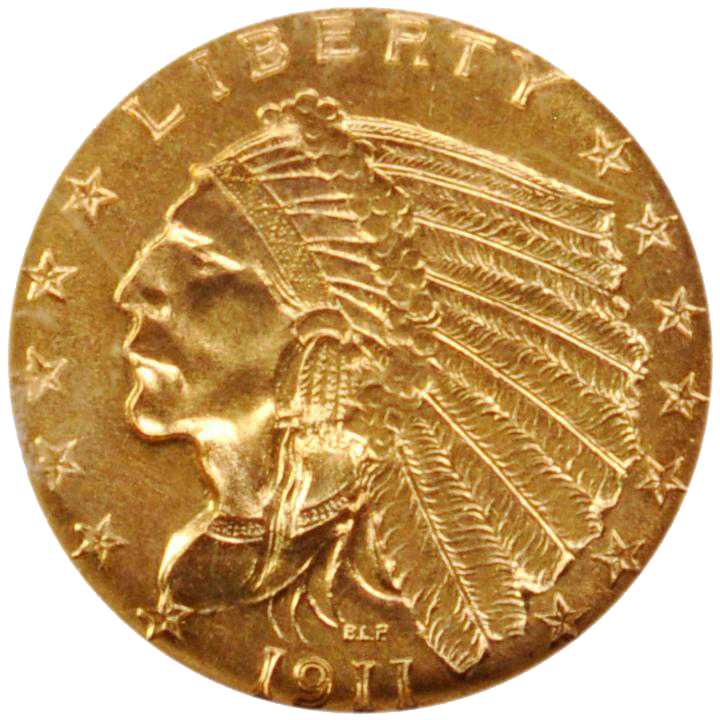
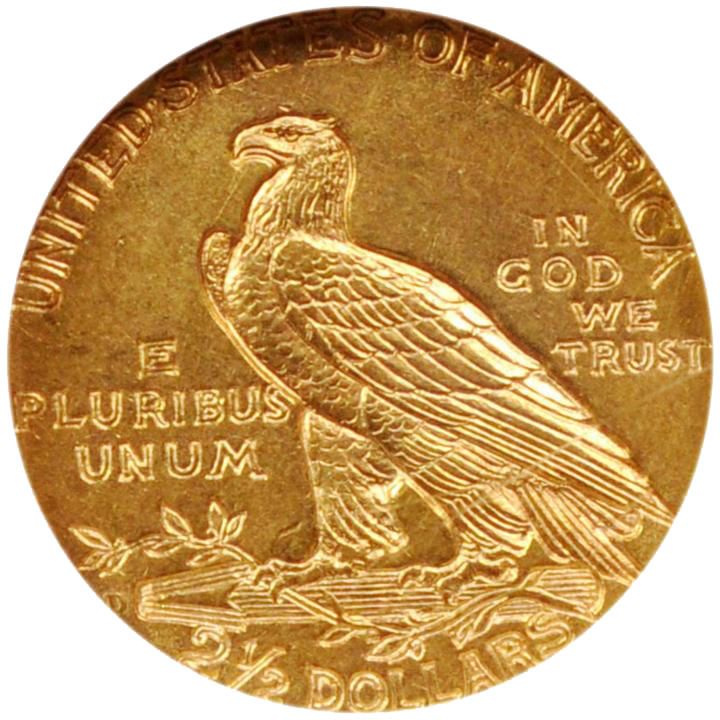
$5 Indian Head Half Eagle
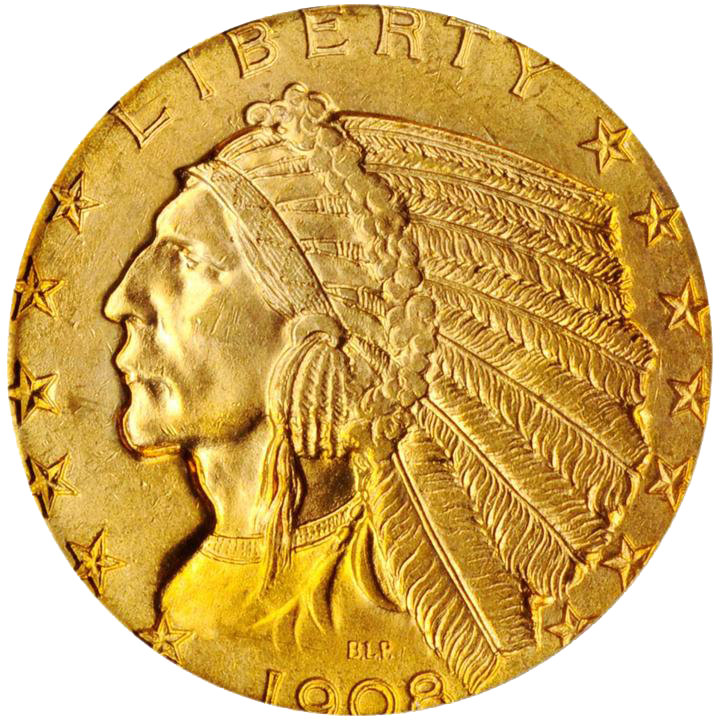
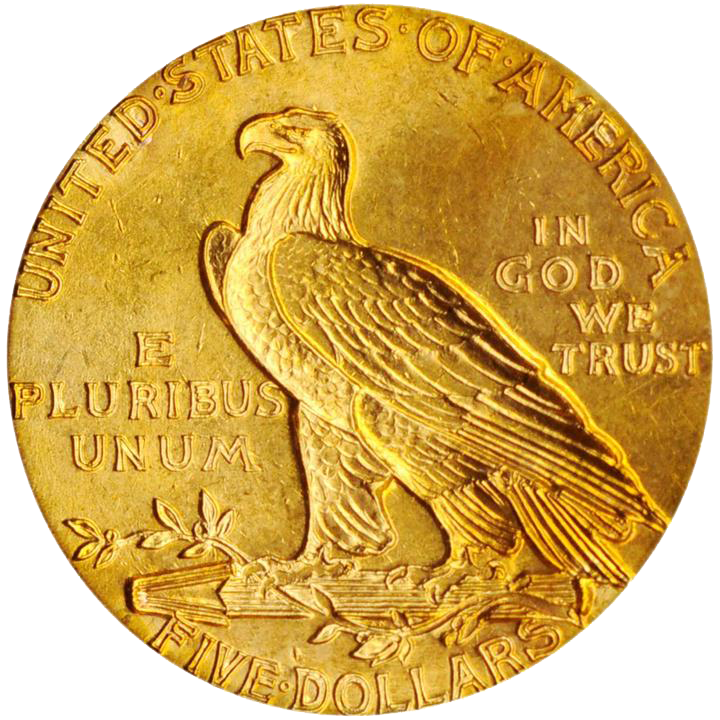
The $20 Saint-Gaudens double eagle is frequently acclaimed as the single most beautiful coin in American History. A case can be made that two smaller United States coins from that same historical period are really much more innovative and daring. At the time they made their appearance, they were also quite a bit more controversial. These two coins are the $2.5 Indian Head quarter eagles and $5 Indian Head half eagles. At the start of the 20th century, the life expectancy of the average American was less than fifty years. The four gold coins then being issued by the Unites States had all been around without a major design change for more than a half a century, the Coronet Liberties, with a portrait of the head of Miss Liberty wearing a coronet. It was time for a change. In 1901, the groundwork was laid for that change when the restless and dynamic President, Theodore Roosevelt, took a personal interest and stamping his imprint upon the entire gamut of national life, including U.S. coinage. It was Roosevelt who arranged for famed sculptor, Augustus Saint-Gaudens, to redesign the $20 double eagle and the $10 eagle gold coins. Roosevelt basked in reflected glory when the stunning new coins debuted in 1907. He then gave his personal blessing to redesigning the two remaining gold coins the following year. The Indian Head quarter eagle and its larger companion, the half eagle, stand out from all the rest of United States coinage because their designs and lettering are sunken in a plane that is uniformly flat. That design is known today as being “incuse.”
The highest points of the relief are level with the coin’s fields, and they have no raised rims to protect them from wear. In fact, the only element of the coins to exceed the level of their fields is the mint mark, if any. The prominent sculptor, Bela Lyon Pratt, got the assignment of fashioning the new designs. Unlike Saint-Gaudens, who had come up with different designs for the double eagle and eagle, Pratt provided identical portraits for both of the smaller coins, but their dignity and strength amply justify this added exposure. Pratt’s obverse depicts a realistic looking Indian brave in a war bonnet, with the date, thirteen stars, and the motto, LIBERTY, forming a circle around the central device. The reverse shows an eagle in repose, perched upon fasces and an olive branch, the intertwined symbols of preparedness and peace. Through judicious sizing and placement, Pratt succeeded in incorporating four different inscriptions on this side, UNITED STATES OF AMERICA, E PLURIBUS UNIM, the motto IN GOD WE TRUST, and its denomination without causing the coin to seem unbalanced and cluttered. In 1908, the public received the coins with mixed feelings.
Many appreciated the design’s artistic merits, while the majority questioned the coin’s ability to stack. Furthermore, the incusing of the design elements stirred criticism. A Philadelphia coin dealer, Samuel H. Chapman, found it particularly objectionable, warning President Roosevelt that the “sunken design” would lead to a multitude of problems from counterfeiting, and most of all, he believed that the recessed areas of the coins would get packed with filth and diseases, but the president remained unshaken in his support for the coins. The $2.5 Indian Head quarter eagles were issued annually from 1908 through 1915. At that point, the mint suspended their production for a decade, resuming in 1925. The coins were struck for five more years before the series ended in 1929 due to that year’s Wall Street crash. As the depression took hold, what little gold came into the mint was used for production of double eagles. With cessation of gold coinage and the great recall of 1933, the Indian Head quarter eagles and half eagles would not return. With just 15 different date and mintmark combinations, the series is one of the smallest in U.S. coinage, making a complete set more attainable for many collectors and investors. Its affordability is enhanced by the fact that only one coin, the 1911-D, is notably scarce with a mintage of only 55,680 pieces.
The Indian Head half eagles were issued annually from 1908 through 1916. 1909 was the only year four different mints struck the Indian half eagles. After 1916, production was suspended for 13 years, it then resumed for one last hurrah in 1929 at the Philadelphia Mint before the series ended for good in the face of the Great Depression. The 1929 half eagle is the big key to the series, worth several thousand dollars even in circulated grades. Records list its mintage as 662,000, but the vast majority were melted. Other scarce dates include the coveted 1909-O, the only New Orleans issue for the series, 1911-D, and 1908-S, all with mintages under 100,000. The Indian Head quarter eagles and half eagles may not be quite as magnificent as the Saint-Gaudens coinage, but it has its fair share of admirers and has long overcome its early criticism. Without illegal hoarding, most of the coins would be lost forever as the Indian Head quarter eagles and half eagles were the most melted due to their seeming design flaws back then. Their controversial history makes for a fun and satisfying collection.
$10 Indian Head Eagle
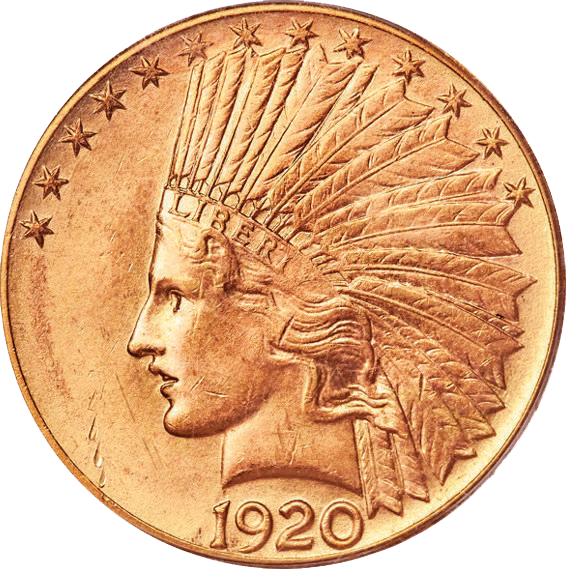
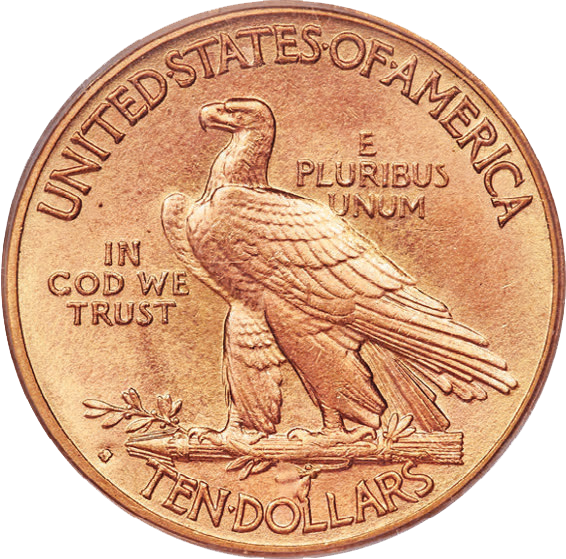
Augustus Saint-Gaudens accepted the challenge by Theodore Roosevelt, in changing the face of the long-standing Coronet Liberty’s two largest gold coins, the $20 double eagle and $10 eagle. He fashioned images of Liberty in both full figure, Like the $20 “Saint,” and bust motifs, and the eagles in flying and standing positions. Although he preferred the bust of Liberty and the standing eagle, which appeared on a 1907 $20 pattern, after much deliberation between Roosevelt and Saint-Gaudens, it was finally decided that this combination would appear on the $10 gold coin. The bust on the new eagle was almost identical to the Nike head, Victory, that Saint-Gaudens designed for Sherman’s monument in New York’s Central Park. At Roosevelt’s insistence, she shed her crown for a handsome, but historically impossible Indian feathered bonnet. LIBERTY is inscribed on the Indian’s headdress, with 13 stars above the head, symbolic for the original thirteen colonies, and the date below. The reverse’s eagle stands on a bundle of arrows, with the motto E PLURIBUS UNIM to the right. Encircling the periphery above the eagle is the legend UNITED STATES OF AMERICA and below is the denomination TEN DOLLARS. The lower relief on the $10 gold coin, compared to Saint Gaudens’ controversial high relief double eagle, made it possible to begin the minting of the new $10 coins in 1907 and continued into early 1908. In the beginning of production of the new $10 gold coins, much like the $20 “Saint,” the religious motto IN GOD WE TRUST did not appear, since Roosevelt firmly believed that the use of the Deity’s name on coins smacked of blasphemy and may be used for all sorts of immoral purposes. An offended Congress insisted that the lawfully mandated Act of March 3, 1865 motto, IN GOD WE TRUST, be returned to the coin, and it was placed to the left of the eagle in 1908. The coin’s final design would be struck at the Philadelphia, Denver, and San Francisco mints. The mintmarks appear to the left of the bundle of arrows, on which the eagle rests on the reverse of the coin.
The $10 Indian Head gold coins were struck at all three Mints from 1908 through 1911, and 1914. Only Philadelphia and San Francisco struck eagles in 1912, 1913, and 1915, and only San Francisco struck them in 1916 and 1920. Few Americans noticed, but in 1912, there were two more stars added to the edge, making it 48 stars instead of 46, honoring statehood achieved by Arizona and New Mexico. Coinage throughout the 1920’s was sporadic, representing only four dates: 1926, 1930-S, 1932, and 1933, before President Franklin Roosevelt’s Executive order of 1933, ending all circulation of gold coins and notes. Most 1933 Indian eagles were melted into ingots, disappearing with hundreds of thousands of other historic gold coins in the wake of the Presidential directive.
$20 Saint-Gaudens Double Eagle
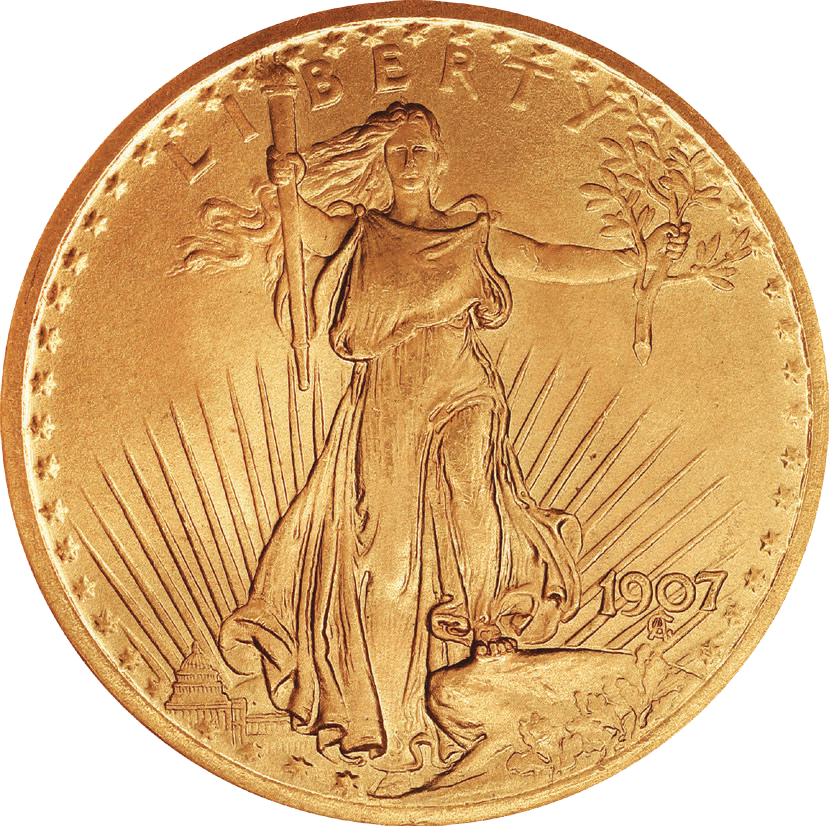
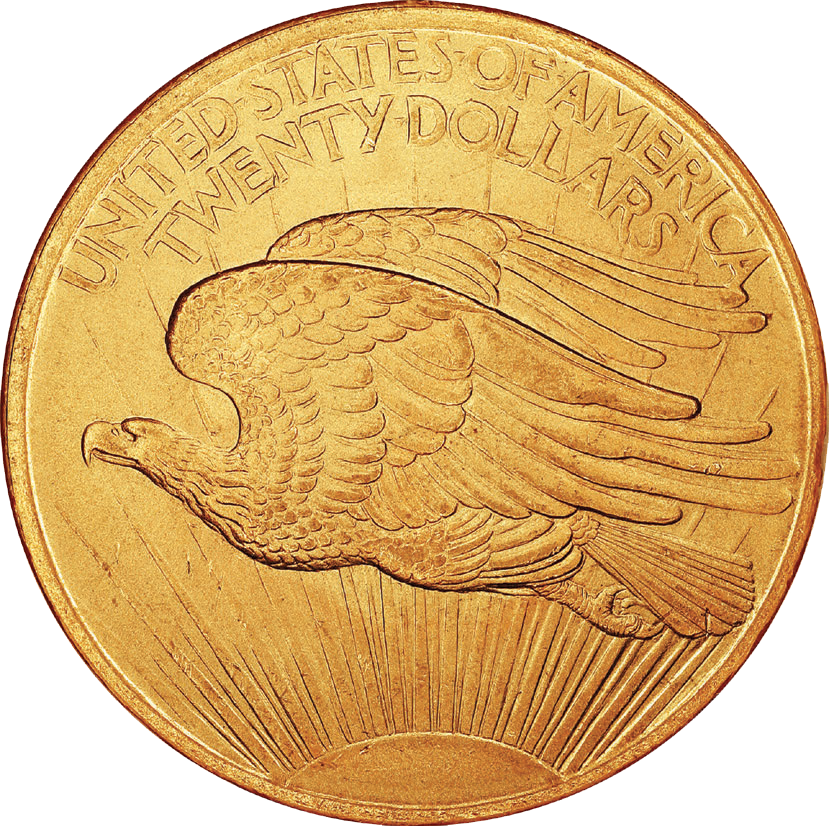
What’s the most beautiful U.S. coin ever made? Whenever that question arises, one of the first most frequent answers is sure to be the Saint-Gaudens double eagle, or the “Saint” for those who know the subject well. This stunning coin resulted from a unique relationship between two well established figures of their day. Augustus Saint- Gaudens, the most famous American sculptor at the turn of the 20th century, and President Theodore Roosevelt, whose pursuit of excellence encompassed the nation’s coinage. In 1905, Roosevelt personally prevailed upon Saint-Gaudens to design his official inaugural medal, which proved to be exceptionally handsome. At a Washington dinner party, they discussed their mutual admiration for the coinage of ancient Greece, and the president urged Saint-Gaudens to create a series of U.S. coin designs based on those classic models. Saint-Gaudens accepted the challenge eagerly and began preparing dramatic new designs to replace the long-running $20 Coronet Liberty double eagle and $10 eagle, the two largest U.S. gold coins, both of which carried the same design for more than half a century. The coins created emerged as masterworks of numismatic art. Unfortunately, Saint-Gaudens health was deteriorating as the project went along. He created superb examples for both. The double eagle especially is a masterpiece. Its obverse features a full-length portrait of Liberty with a torch in her right hand and an olive branch in her left. She is shown in full stride, with rays of sunlight behind her as the sun is setting, and the U.S. Capital Building to the left of her flowing gown. Encircling her are 46 stars, one for each state in the Union at that time. The coin’s reverse depicts a breathtaking eagle in flight, with the sun below extending its rays upward. Above the eagle, in two semicircular tiers, are the inscriptions UNITED STATES OF AMERICA and TWENTY DOLLARS.
Saint-Gaudens placed another required motto, E PLURIBUS UNUM, along the edge of the coin, reducing the clutter on the obverse and reverse and reinforcing its clean open look. He and Roosevelt conspired to omit IN GOD WE TRUST from the first of the new double eagle, but God-fearing members of Congress noticed this and mandated the addition of the motto on their later issues, starting near the end of 1908. On pieces produced thereafter, it appears above the sun on the reverse. Roosevelt and Saint-Gaudens intended that the coin be struck in high relief like the ancient coins of Greece to bring out each exquisite detail. Unfortunately, Saint Gaudens died in 1907, almost on the eve of the coin’s debut. Meanwhile, Roosevelt was preoccupied with other pressing matters of state and gave Mint Chief Engraver, Charles E. Barber, a chance and an excuse to reduce the coin’s relief. According to Barber, this was required for high-speed minting. Another issue was the high relief coins would not stack. The beauty of the coin remained dazzling even after the changes made by Charles Barber. Thankfully, Saint-Gaudens original art was preserved in its pristine beauty through the minting of a small number of extremely high relief patterns and high relief business strikes in 1907, or rather MCMVII, for the date shown on these coins was in Roman numerals. “Saints” were minted each year from 1907 through 1916. A three-year period of hiatus followed, after which the coins were struck yearly from 1920 through 1933. The branch mints in Denver and San Francisco augmented the main Philadelphia Mint production, but not in every year. The mint marks appear above the date and the designer’s initials (ASG) below.
From 1929 onward, newly minted examples were held almost entirely as part of the nation’s gold reserves, with few being released into circulation. Almost all of these were melted following the recall order signed by Theodore’s cousin, President Franklin Roosevelt in 1933. As a result, double eagles dated 1929 through 1933 are exceedingly rare today. The mint produced nearly a half a million pieces dated 1933, but the government maintains that these were never released, thus making them illegal to own. Only a single 1933 $20 Saint currently resides in a private collection, while two examples have been preserved within the collection of the Smithsonian Institution. That was the end of U.S. issued gold coinage. In 1986, the U.S. Treasury paid the highest compliment by placing Saint-Gaudens’ obverse design on the Gold American Eagles, where it has remained ever since.
